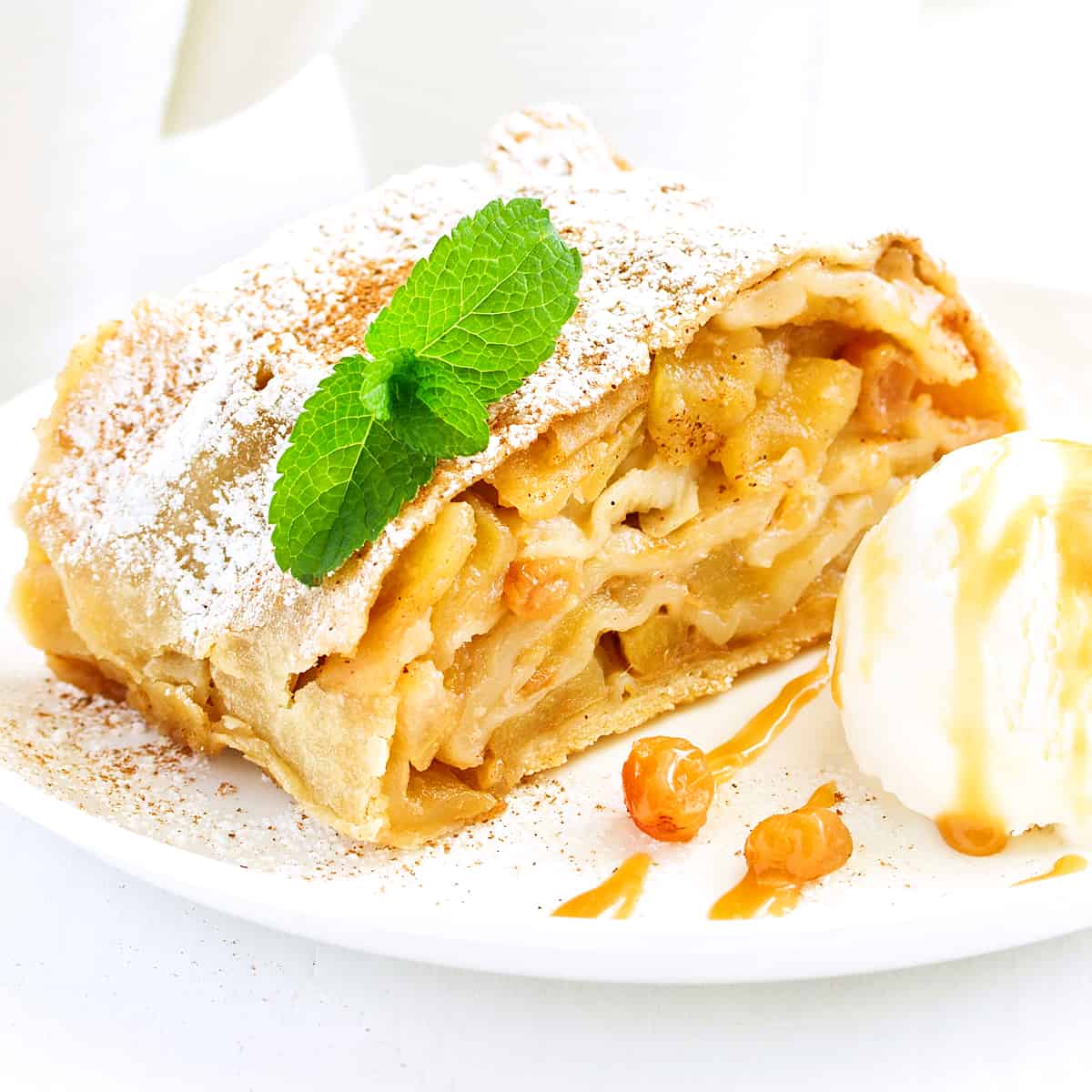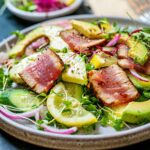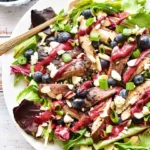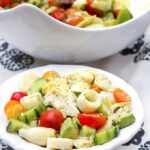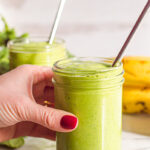German cuisine is rich with tradition and history, and its desserts are no exception. From mouthwatering pastries to delightful cookies, German desserts offer a taste of the country’s culture and heritage. What makes German desserts unique is their blend of classic flavors and comforting ingredients, resulting in treats that are both familiar and unique.
When you explore German desserts, you’ll discover a variety of flavors and textures, often using ingredients like apples, cinnamon, and almonds. These recipes have been passed down through generations, ensuring every bite is a piece of German culinary history.
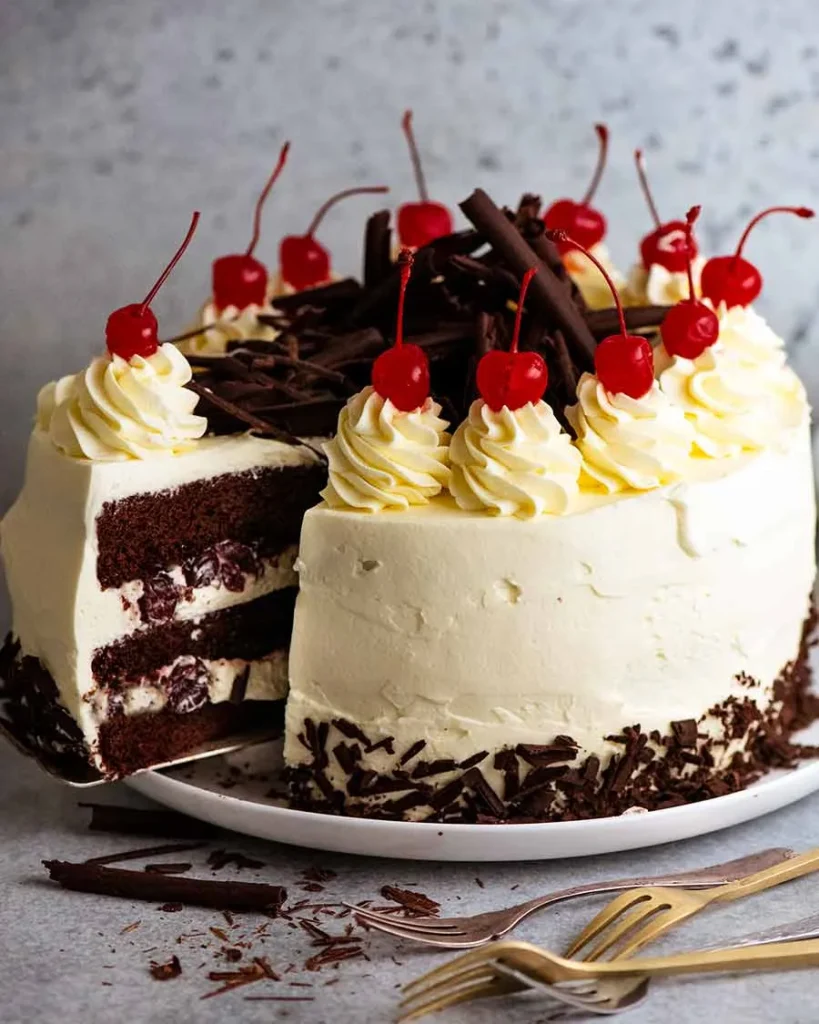
1) Black Forest Cake
Black Forest Cake, known in Germany as Schwarzwälder Kirschtorte, is a popular dessert. This cake features layers of chocolate sponge cake, whipped cream, and cherries.
You begin by mixing eggs, sugar, butter, and vanilla until creamy. Then, you sift in flour, cocoa, baking powder, and salt, mixing until combined. Pour the batter into a parchment-lined baking pan.
Bake the cake at 350°F for about 30-35 minutes. Check doneness with a toothpick; it’s ready when it comes out clean. Let the cake cool in the pan for a few minutes, then completely on a rack.
While the cake cools, prepare the filling using fresh or canned cherries. Heat cherry juice and mix with a starch solution. Add the cherries, sugar, and Kirsch Schnaps if desired. Let it cool.
Once the cake is cool, slice it into layers. Spread whipped cream and the cherry filling between each layer. Finish the cake with a final layer of whipped cream and garnish with chocolate shavings and cherries.
This delightful dessert’s combination of flavors and textures makes it a beloved treat in Germany and around the world.
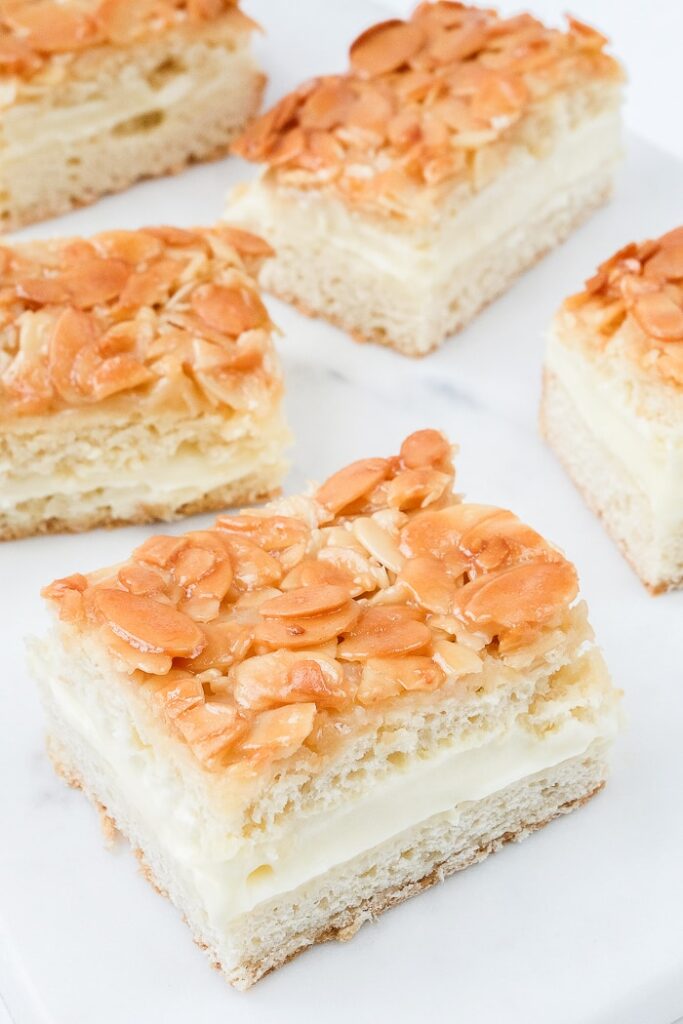
2) Bienenstich
Bienenstich, also known as Bee Sting Cake, is a classic German dessert. It features a sweet yeast dough topped with a caramelized almond and honey mixture.
You begin by preparing the dough and letting it rise. While it rests, you make the almond topping with butter, honey, sugar, and cream.
After spreading the almond mixture over the dough, bake it at 350°F until golden brown. Once baked, the cake needs to cool to allow the topping to firm up.
The filling is typically a rich custard or cream. Slice the cake in half horizontally, then spread the filling between the layers before serving.
The combination of the fluffy cake, creamy filling, and crunchy almond topping makes Bienenstich a delightful treat.
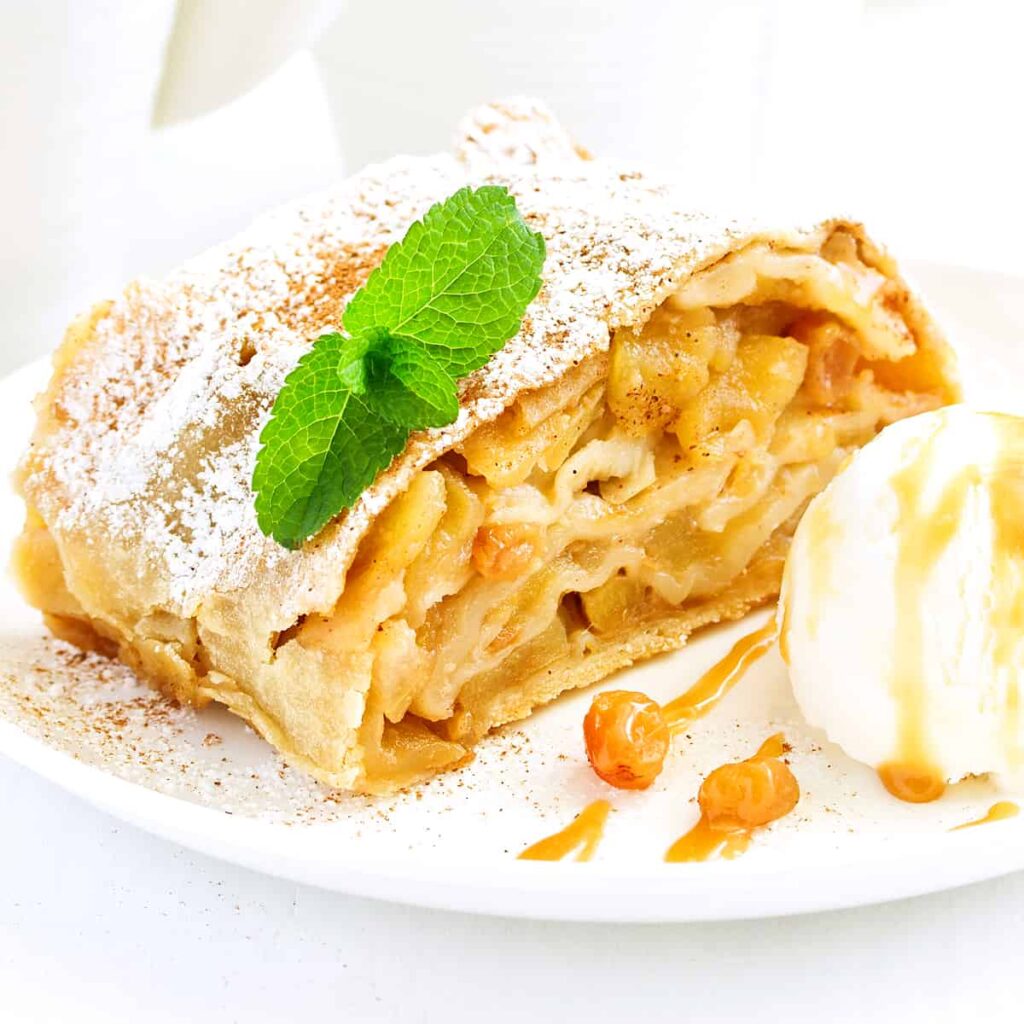
3) Apfelstrudel
Apfelstrudel, or Apple Strudel, is a classic German dessert known for its flaky pastry and sweet, spiced apple filling.
The dough for Apfelstrudel is made by mixing flour, salt, water, and oil until smooth. After kneading, it needs to rest for about an hour. This helps it become stretchy and easy to roll out thinly.
Once the dough is ready, you roll it out on a floured surface. Brush it with oil to keep it moist.
The filling typically consists of apple slices, sugar, cinnamon, raisins, and nuts like walnuts or almonds. You might also add a bit of lemon juice for a touch of acidity.
Spread the filling evenly over the rolled-out dough. Carefully roll the dough into a log with the help of a kitchen towel. Brush the outside with more oil or melted butter.
Bake the Apfelstrudel in a preheated oven until golden brown and crispy. When done, let it cool slightly, then dust it with powdered sugar before serving.
Apfelstrudel is often enjoyed warm, sometimes with a dollop of whipped cream or a scoop of vanilla ice cream. Its combination of textures and flavors makes it a beloved treat that captures the spirit of German baking.
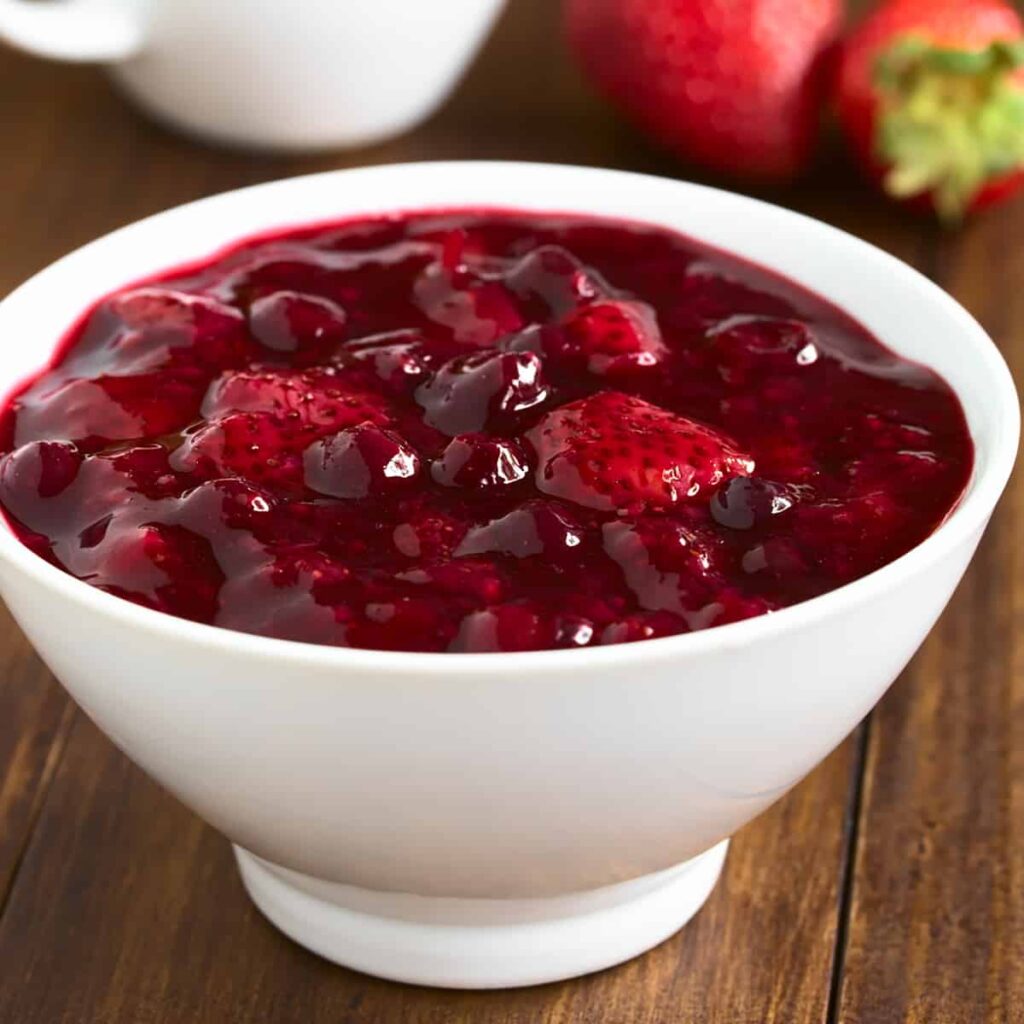
4) Rote Grütze
Rote Grütze is a classic German dessert made with red berries. It’s known for its vibrant color and sweet, tart flavor. You’ll often find it served during the summer when berries are fresh and plentiful.
To prepare Rote Grütze, you start by washing and cutting the berries. Common choices include strawberries, raspberries, and currants. Then, you cook the berries with sugar and a bit of fruit juice until they soften.
Cornstarch mixed with a small amount of juice is used to thicken the mixture. The result is a pudding-like consistency that’s rich and satisfying. Once it’s thickened, you remove it from the heat and let it cool.
Serving Rote Grütze is simple. Spoon it into bowls and pair it with vanilla sauce, heavy cream, or even ice cream. The creamy addition balances the tartness of the berries perfectly. This dessert is a delightful way to enjoy the natural sweetness of summer fruits.
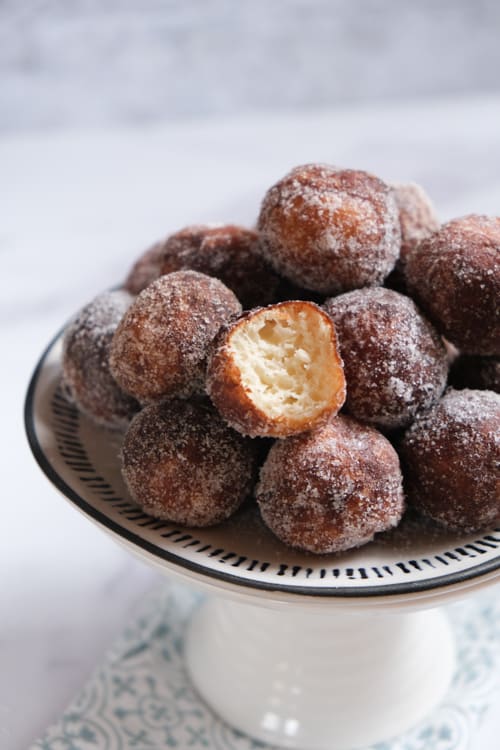
5) Quarkbällchen
Quarkbällchen are a popular German treat made from a dough that includes quark, a type of fresh dairy product. These delightful balls are deep-fried until golden brown and then rolled in a cinnamon-sugar mixture while still hot.
The dough for Quarkbällchen typically contains flour, yeast, sugar, vanilla sugar, eggs, and butter. Quark adds a unique texture and flavor to the dough, making these balls soft and slightly tangy. Lemon zest can also be added for a hint of citrus.
To prepare Quarkbällchen, you need to shape the dough into small balls, about the size of a golf ball. Deep-fry them in hot oil until they turn golden brown. Make sure they float in the oil and don’t touch each other to cook evenly.
Once the Quarkbällchen are fried, place them on paper towels to drain any excess oil. While they are still warm, roll them in a mixture of sugar and cinnamon. This coating adds a sweet and spicy touch that makes them irresistible.
Quarkbällchen are best enjoyed fresh but can also be stored in an airtight container for a few days. They make a fantastic snack or dessert that pairs well with a cup of coffee or tea.
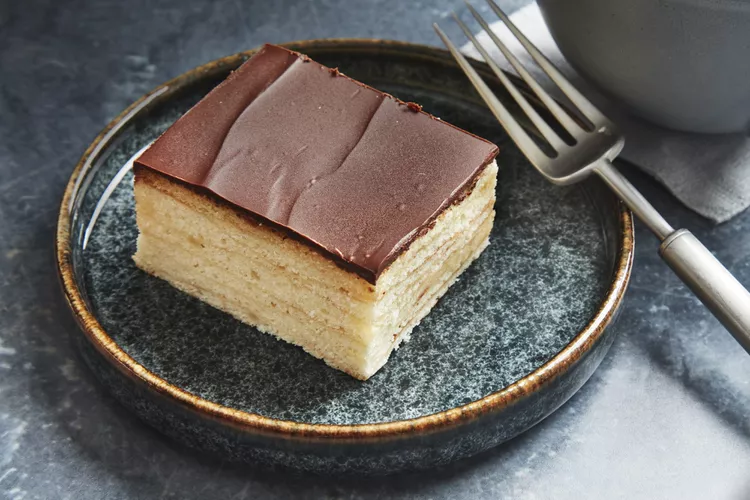
6) Baumkuchen
Baumkuchen, also known as the “tree cake,” is a traditional German dessert. It is named for its characteristic appearance, which resembles tree rings when sliced.
The cake is made by layering batter onto a rotating spit or in a special pan under a broiler. Each layer is browned before adding the next one. This creates the signature rings.
The batter typically includes flour, butter, eggs, sugar, and almond extract. Some recipes might also call for vanilla or a bit of salt to enhance the taste.
When preparing Baumkuchen, patience is key. Each layer needs to be cooked carefully to ensure even baking and the characteristic layered look. This process can take time but results in a unique and delicious cake.
Baumkuchen is enjoyed during holidays and special occasions in Germany. You can often find it coated with a thin layer of chocolate or icing for extra sweetness.
Making Baumkuchen at home involves some effort, but it’s well worth it for the impressive and tasty result.
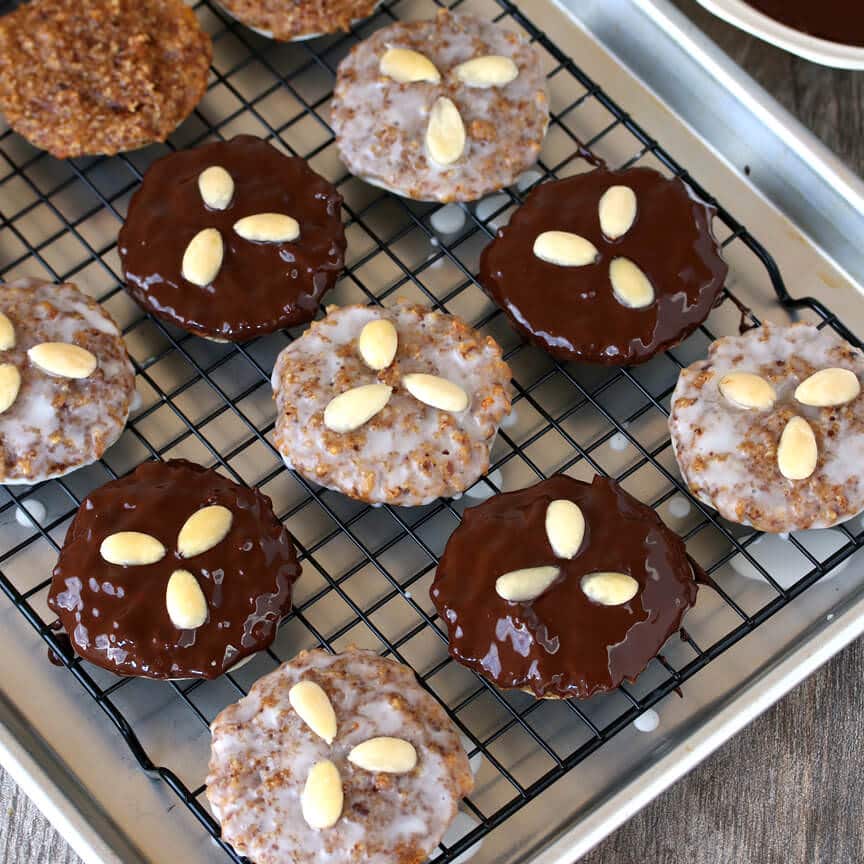
7) Lebkuchen
Lebkuchen, often called German gingerbread, is a classic treat during the Christmas season. You will find these cookies in many German homes and Christmas markets.
This dessert has a rich history dating back to the 14th century. It was first made by monks in Franconia, Germany. The recipe has stayed popular for centuries.
The dough typically includes ingredients like honey, spices, and nuts. Common spices used are cinnamon, cloves, and ginger. These give Lebkuchen its unique flavor.
To make Lebkuchen, you start by mixing honey and sugar in a saucepan. Heat gently until the sugar dissolves, then add butter. Allow the mixture to cool slightly before adding it to the dry ingredients, such as flour and ground nuts.
Once your dough is ready, you can scoop it into small balls or shape it into rectangles. Bake the cookies until they are lightly browned. The baking time usually ranges from 10 to 20 minutes.
Glazing is optional but adds a nice touch. A common glaze uses powdered sugar, lemon juice, and vanilla. You can also use chocolate glaze by melting dark chocolate with a bit of oil.
These cookies are soft and chewy, making them a favorite for holiday celebrations. If you want to store them, keep them in an airtight container. They can last several weeks and still taste fresh.
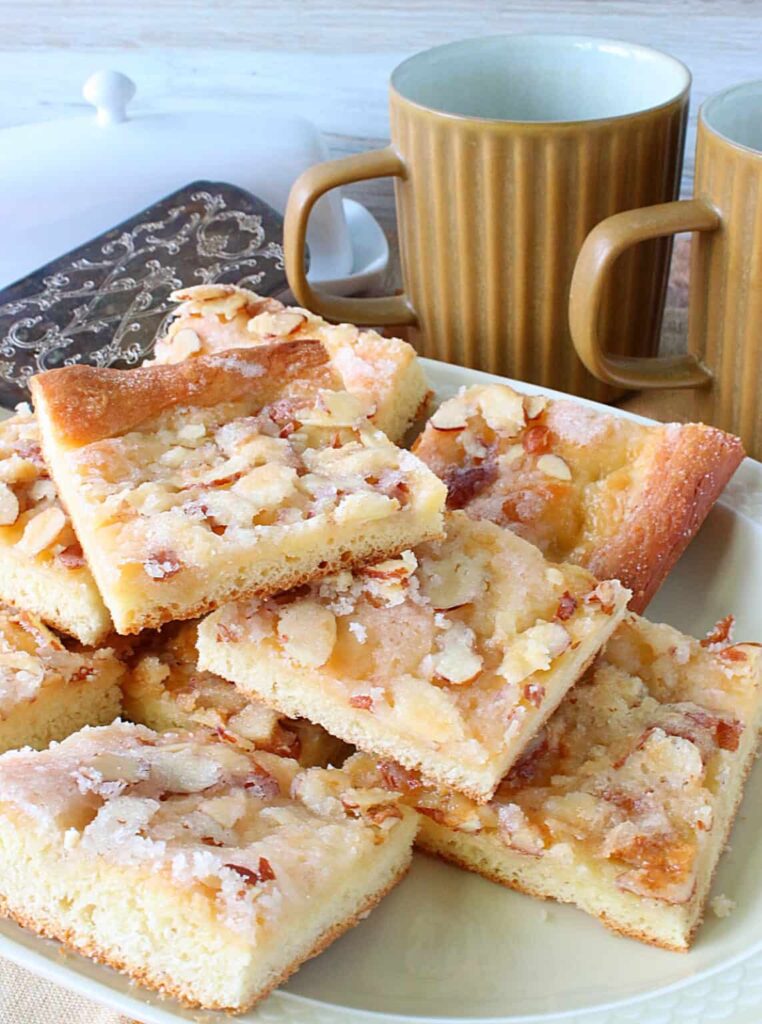
8) Zuckerkuchen
Zuckerkuchen, also known as German Sugar Cake, is a beloved traditional dessert. This cake is particularly known for its simplicity and sweet, buttery flavor.
To begin, you mix yeast with a little lukewarm milk and sugar, letting it foam to activate. This is crucial for getting the right texture.
In another step, you create a dough by combining the yeast mixture with flour, eggs, more milk, and melted butter. Knead it until smooth, cover it, and let it rise.
Once the dough has risen, press it into a baking dish. Next, use the end of a wooden spoon to create small indentations in the dough. This is where you’ll place bits of butter for added richness.
Sprinkle the dough generously with sugar before baking. This gives Zuckerkuchen its characteristic sweet crust.
Bake the cake in a preheated oven until golden brown. The result is a soft, fluffy interior with a delectable sugary topping.
Zuckerkuchen is perfect for any occasion and pairs wonderfully with coffee or tea.
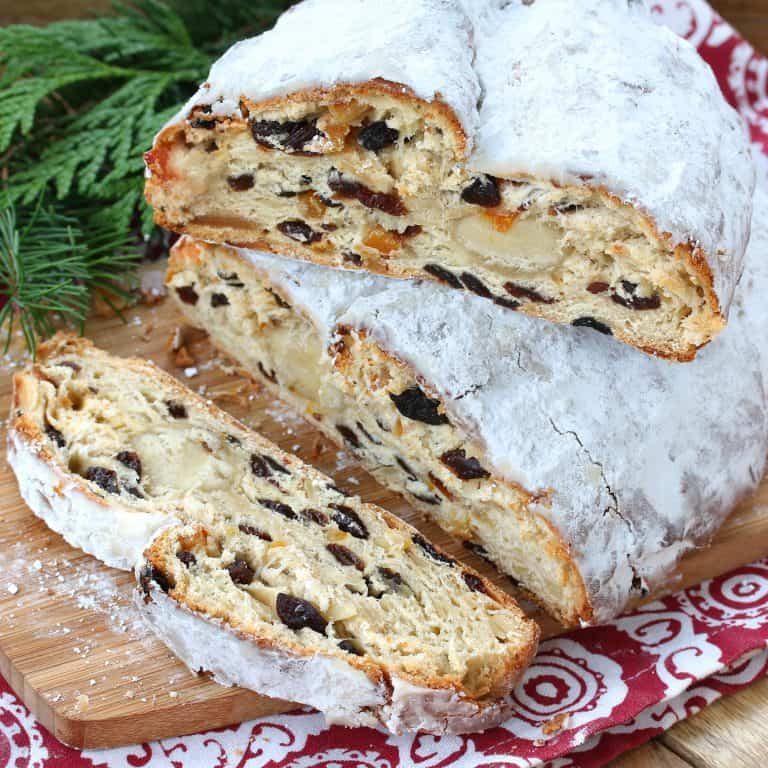
9) Stollen
Stollen is a traditional German Christmas bread. It is rich, dense, and lightly sweetened. You will often find it filled with dried fruits, nuts, and marzipan. The bread is flavored with spices like cardamom, cinnamon, and mace.
Making Stollen can be a labor of love. Start by mixing flour, yeast, sugar, and spices in a bowl. Warm butter and milk together, then combine these with the dry ingredients. Add eggs and vanilla, then knead the dough until smooth.
Let the dough rise in a warm place until it has doubled in size. This can take about an hour. After rising, shape the dough into a loaf, often with a roll of marzipan in the center. Allow it to rise again for another 45 minutes.
Bake Stollen in a preheated oven at 350 degrees Fahrenheit for about 50 minutes. Check if it’s done by inserting a toothpick into the bread; it should come out clean. Once baked, let it cool completely.
To finish, brush the cooled Stollen with melted butter and cover it with powdered sugar. This helps preserve the bread and gives it a festive look. For the best flavor, let it rest for a week before cutting and serving.
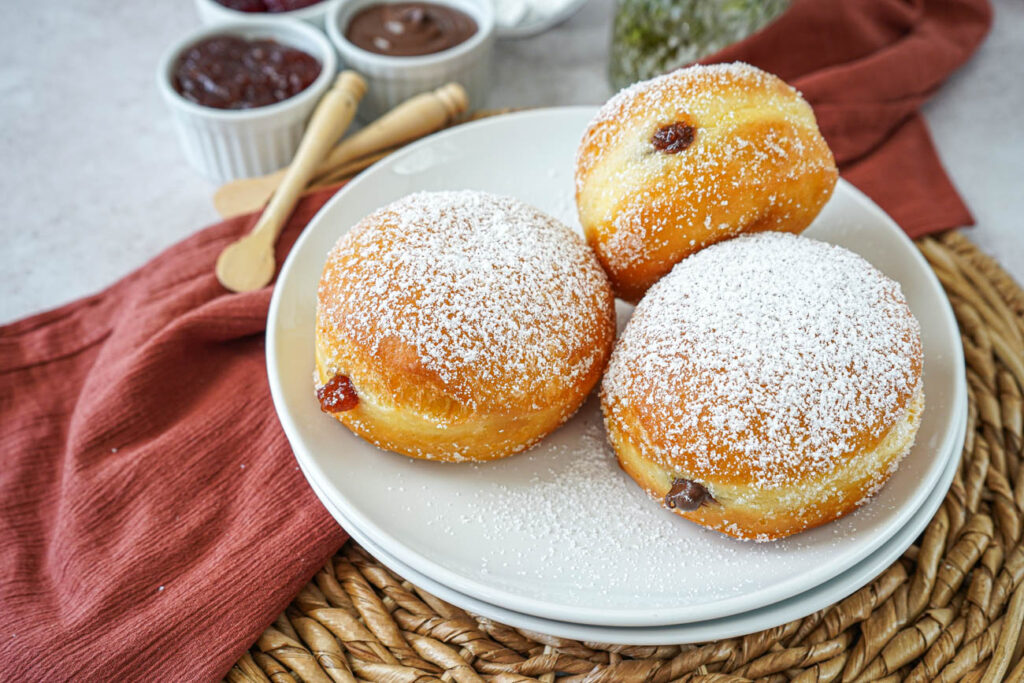
10) Berliner
The Berliner, also known as a jelly doughnut, is a popular German treat. It’s a round pastry without a hole, typically filled with jam or other sweet fillings. The most common fillings are raspberry or strawberry jam, but sometimes you might find them with custard or chocolate.
You usually find Berliners covered in powdered sugar or regular sugar, giving them a sweet, crunchy exterior. They are often enjoyed during celebrations like New Year’s Eve and carnival seasons.
To make Berliners, you start with a sweet yeast dough. After letting the dough rise, it’s shaped into balls and left to proof. These dough balls are then deep-fried until golden brown.
Once fried, they’re filled with jam using a piping bag. Finally, they’re rolled in sugar. Fresh and warm, Berliners are a true delight to taste.
Though they originated in Berlin, you can find them all over Germany. They’re sold in bakeries and enjoyed by people of all ages. Whether for breakfast or a snack, Berliners offer a delicious bite of German tradition.
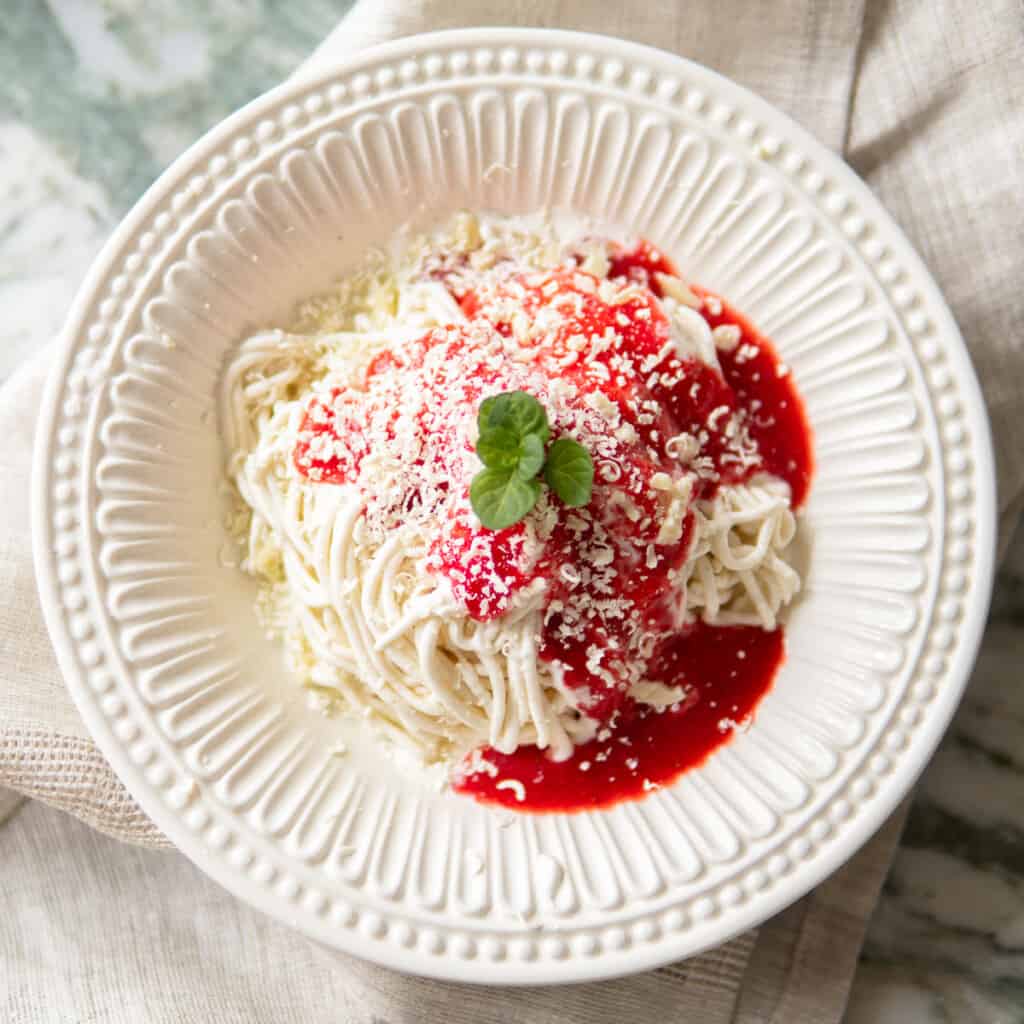
11) Spaghettieis
Spaghettieis is a fun and creative German dessert that looks like a plate of spaghetti. This sweet treat is made using vanilla ice cream, strawberry sauce, and white chocolate.
To start, chill a potato ricer or Spätzle press, an ice cream scoop, and serving plates in the freezer. This keeps the ice cream from melting too quickly.
Place a dollop of whipped cream on a chilled plate or bowl. Scoop some vanilla ice cream into the potato ricer. Press the ice cream through the ricer to create long strands that resemble spaghetti noodles.
Next, prepare a strawberry sauce by blending strawberries, orange juice, and sugar until smooth. Use this sauce to top the ice cream “noodles,” mimicking marinara sauce.
Grate some white chocolate to sprinkle over the top, resembling Parmesan cheese. Serve immediately, and enjoy this delightful and playful dessert.
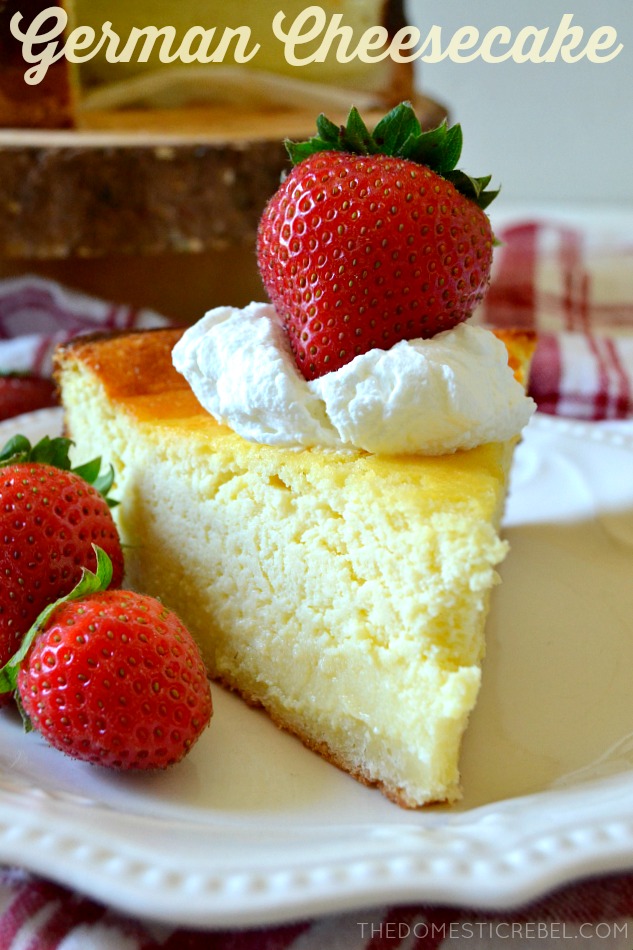
12) Käsekuchen
Käsekuchen is a classic German cheesecake. It’s loved for its unique, creamy texture and distinct flavor. This dessert is lighter than American cheesecake, often made with a special ingredient called quark, a type of fresh cheese.
To make Käsekuchen, you start with a basic crust. Mix butter, sugar, and an egg with flour until it becomes dough. This dough is then pressed into a springform pan and baked.
For the filling, combine quark with sugar, egg yolks, lemon juice, and cornstarch until smooth. Beat egg whites separately until they form stiff peaks, then fold them gently into the quark mixture. This helps the cheesecake achieve a light, airy texture.
Once the filling is ready, pour it into the crust and smooth the top. The cheesecake is baked at a low temperature, around 300°F (150°C), for about 60 to 70 minutes. The cake is done when the edges are browned and a toothpick inserted in the center comes out clean.
Käsekuchen can be enjoyed plain or with toppings like fresh fruit or powdered sugar.
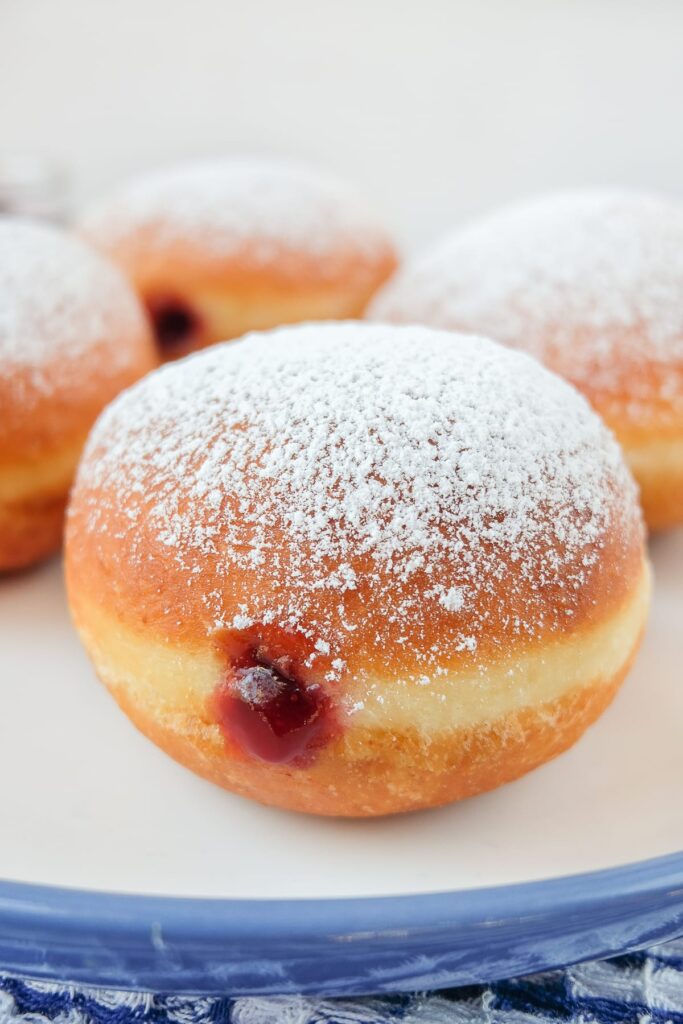
13) Krapfen
Krapfen, also known as German jelly-filled donuts, are a popular treat in Germany. They are made from a soft, yeasty dough that is fried until golden brown. Once fried, they are filled with jam or custard.
The dough for Krapfen is rich with ingredients like butter, sugar, eggs, and sometimes grated orange peel. It is kneaded and left to rise before being shaped into balls.
The frying process is crucial. You need to heat the oil to the right temperature, between 360°F to 375°F. Fry the dough balls until they are golden and cooked through.
After frying, you can fill the donuts with your favorite jam or custard and sprinkle them with powdered sugar. They are best enjoyed fresh and warm.
Krapfen are particularly popular during the Carnival season, known as Fasching or Karneval in Germany. They are a delightful and indulgent treat that you can easily make at home.
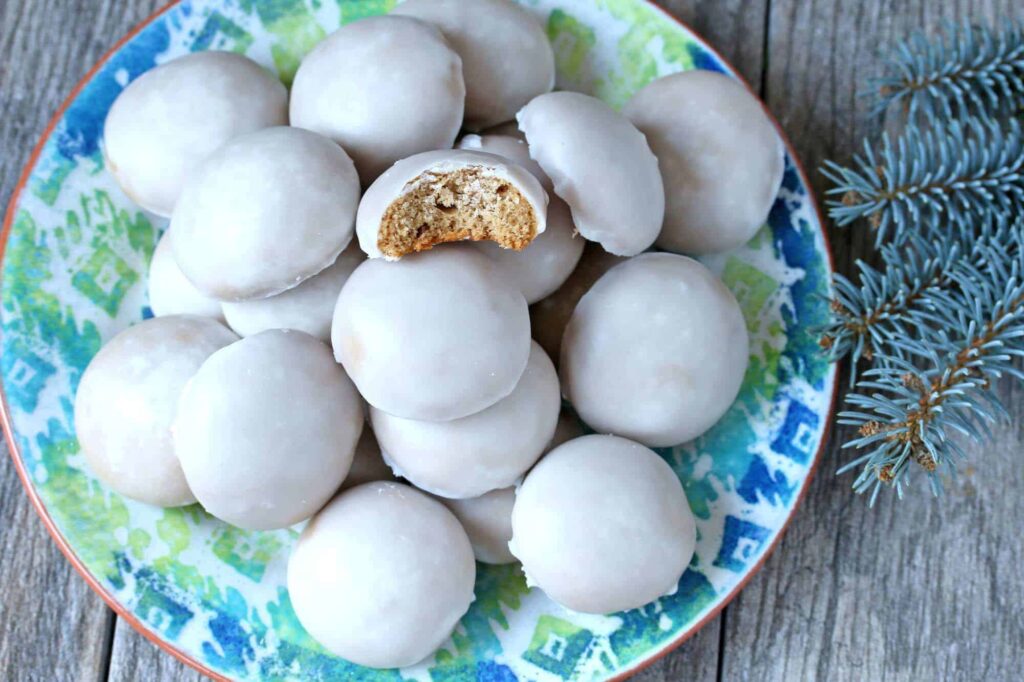
14) Pfeffernüsse
Pfeffernüsse, also known as pepper nuts, are traditional German spice cookies. These cookies are especially popular during the holiday season.
To make Pfeffernüsse, you start by mixing flour, baking soda, a blend of spices like cinnamon, ginger, white pepper, and almond meal.
You’ll heat brown sugar, honey, butter, and cream in a saucepan, stirring until the sugar dissolves. After, combine this mixture with the dry ingredients to form a dough.
Roll the dough into small balls, about an inch in diameter. Place them on a greased or lined baking sheet, spaced about an inch apart.
Bake the cookies at around 350°F for 10-15 minutes or until they are light golden brown. Allow them to cool completely on wire racks before storing or serving.
Traditionally, Pfeffernüsse are coated in powdered sugar, giving them a sweet exterior that complements their spiced interior.
These cookies are known for their slightly crunchy texture and rich, spiced flavor, making them favorites for many during winter festivities.
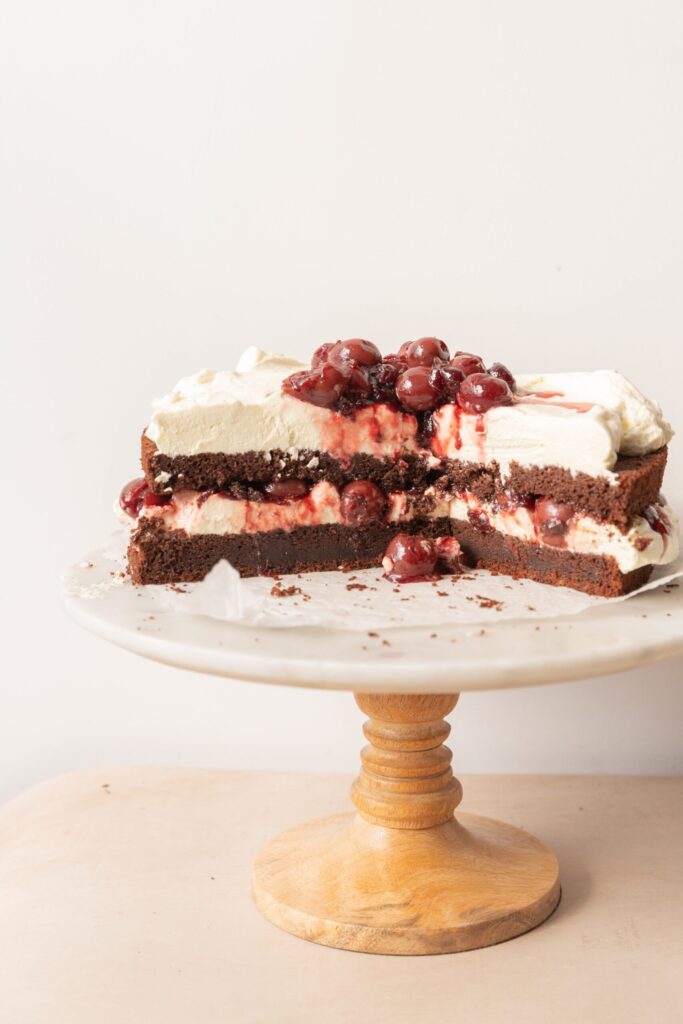
15) Schwarzwälder Kirschtorte
Schwarzwälder Kirschtorte, known as Black Forest Cake in English, is a classic German dessert. It consists of several layers of chocolate sponge cake. Between the layers, there are rich whipped cream and tart cherries.
The cake is often brushed with kirsch, a clear cherry brandy. This adds a unique flavor. Topping it all off, the cake is decorated with more whipped cream, maraschino cherries, and chocolate shavings.
This dessert is popular in Germany and around the world. It is often served at special occasions like birthdays and weddings. Its combination of flavors and textures makes it a delightful treat.
Making Schwarzwälder Kirschtorte can be a bit challenging, but the results are worth it. The steps usually involve baking the sponge cake, preparing the cherries, and whipping the cream. Assembling the layers takes some time and care.
If you’re a fan of chocolate and cherries, this cake is a must-try. The blend of moist chocolate cake, creamy filling, and tangy cherries is irresistible. You might find it in many German bakeries, offering a taste of tradition and indulgence.
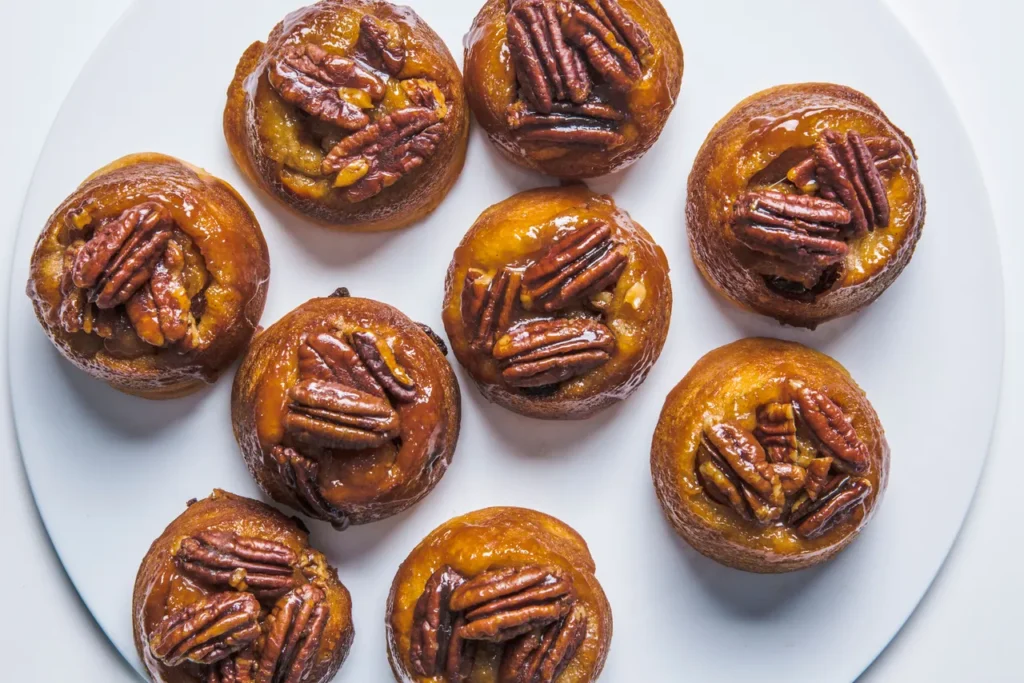
16) Schnecken
Schnecken, a delightful German treat, is similar to cinnamon rolls.
The dough is enriched with butter, milk, and eggs, creating a soft and tender texture.
Pecans and a sticky honey glaze give Schnecken a rich and indulgent flavor.
To make Schnecken, you prepare the dough, then roll it out and spread butter and sugar over it.
The dough is cut into slices and placed in a baking pan.
After rising, the Schnecken bake until golden and fragrant.
Enjoy Schnecken warm, straight from the oven for the best taste.
They pair perfectly with a cup of coffee or tea.
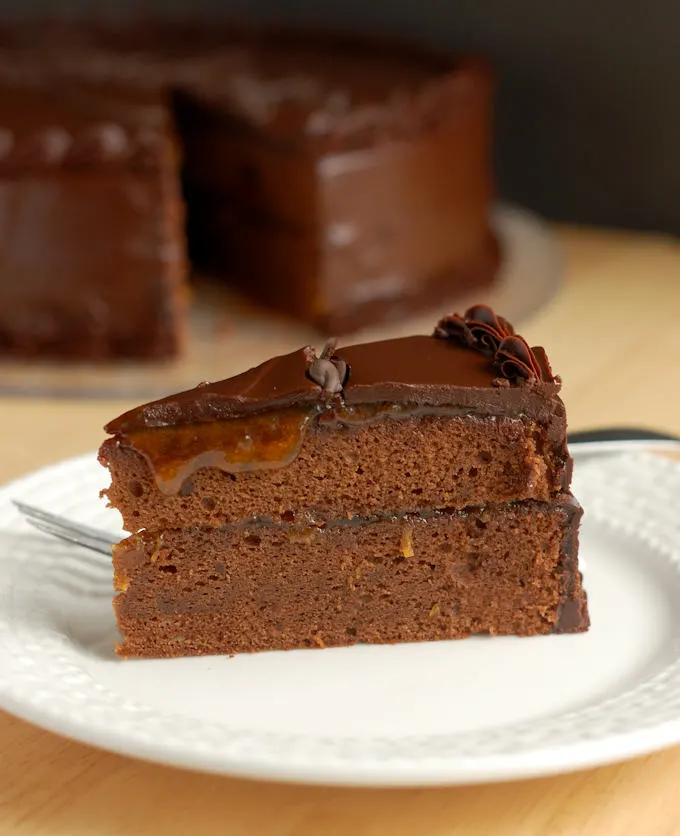
17) Sachertorte
Sachertorte is a famous chocolate cake from Vienna, Austria. It’s known for its rich flavor and smooth texture.
To make a Sachertorte, you start with a chocolate cake base. The cake is cut in half horizontally. Apricot jam is spread between the layers and brushed on the sides.
A chocolate glaze covers the entire cake. This glaze is made from cooking sugar and water together for a few minutes, then adding melted chocolate. It’s poured over the cake while warm.
The cake is often served with a side of whipped cream. This helps balance the dense, rich texture of the cake.
Sachertorte should be stored at room temperature. This keeps it fresh and maintains its flavor. Avoid putting it in the fridge, as this can dry it out.
Sachertorte has become a symbol of Viennese culture. You can find it in many cafes in Vienna, often accompanied by a cup of coffee.
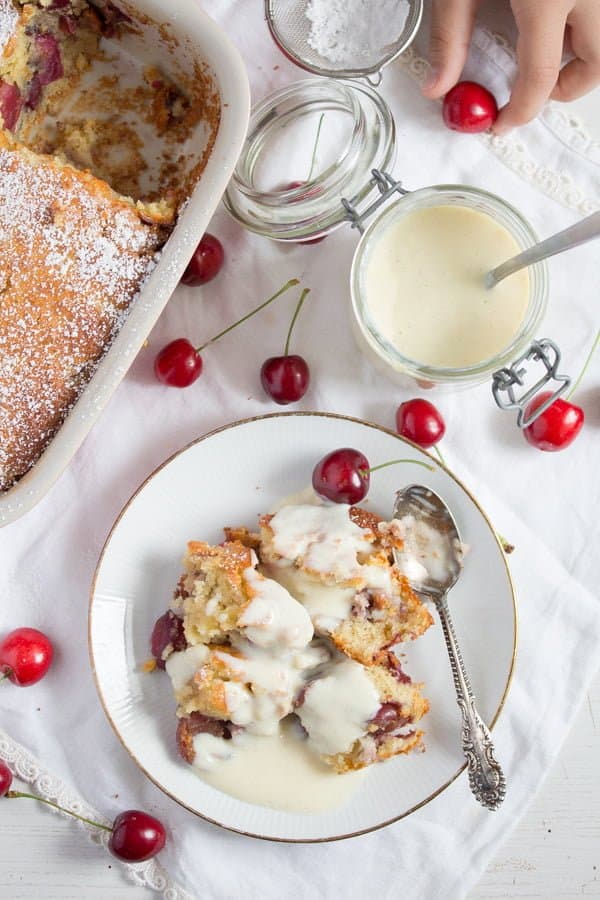
18) Kirschmichel
Kirschmichel is a traditional German dessert made from stale bread, cherries, and kirsch syrup. This dish was a way to use up old bread, transforming it into a delicious treat.
To make Kirschmichel, you start by cutting rolls or bread into slices. Warm milk is then poured over the bread pieces to soften them.
In a separate bowl, beat together butter, sugar, egg yolks, and lemon zest until foamy. Combine this mixture with the soaked bread, stirring carefully to avoid breaking the bread pieces.
The cherries, which can be fresh, frozen, or canned, are then pitted and added to the mix. Vanilla and semolina are also stirred in to enhance the flavor and texture.
Once everything is combined, the mixture is transferred to a baking dish and baked until golden brown. Kirschmichel is often served warm and can be paired with a vanilla sauce for extra flavor.
This dessert combines the tartness of cherries with the richness of the bread pudding, offering a unique taste that’s both nostalgic and comforting. It’s a dessert that brings together simple ingredients in a delightful way.
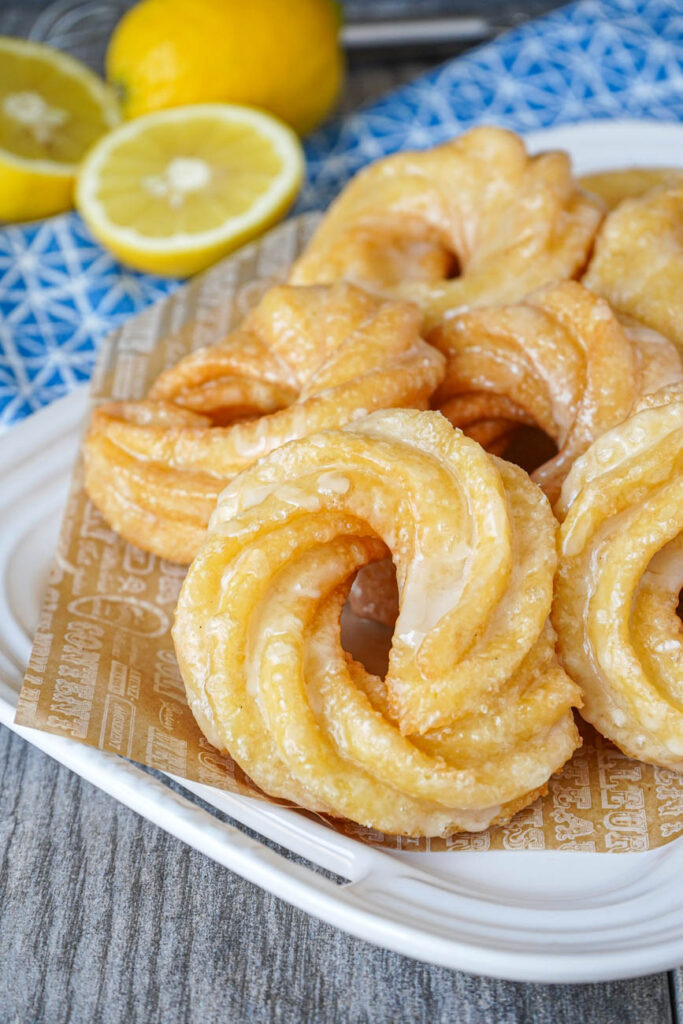
19) Spritzkuchen
Spritzkuchen are traditional German crullers. They are light, airy, and often enjoyed during festivals and special occasions. You can recognize them by their round, twisted shape and glossy glaze.
To make Spritzkuchen, start by preparing the dough. Heat water and butter in a pan until the butter melts. Then, stir in flour and cornstarch until a smooth mixture forms.
Next, pipe the dough onto small squares of parchment paper. Heat the oil to about 180°C (350°F). Carefully place the dough into the hot oil, pulling out the parchment paper. Fry until puffed and golden on both sides.
After frying, dip the warm crullers into a glaze made of powdered sugar and lemon juice, water, or rum. Let them set on a wire rack. The glaze gives Spritzkuchen their distinct sweet, tangy flavor.
Spritzkuchen are best enjoyed fresh. Their crispy exterior and soft inside make them a delightful treat. Whether you make them at home or buy them from a bakery, they are a delicious part of German cuisine.
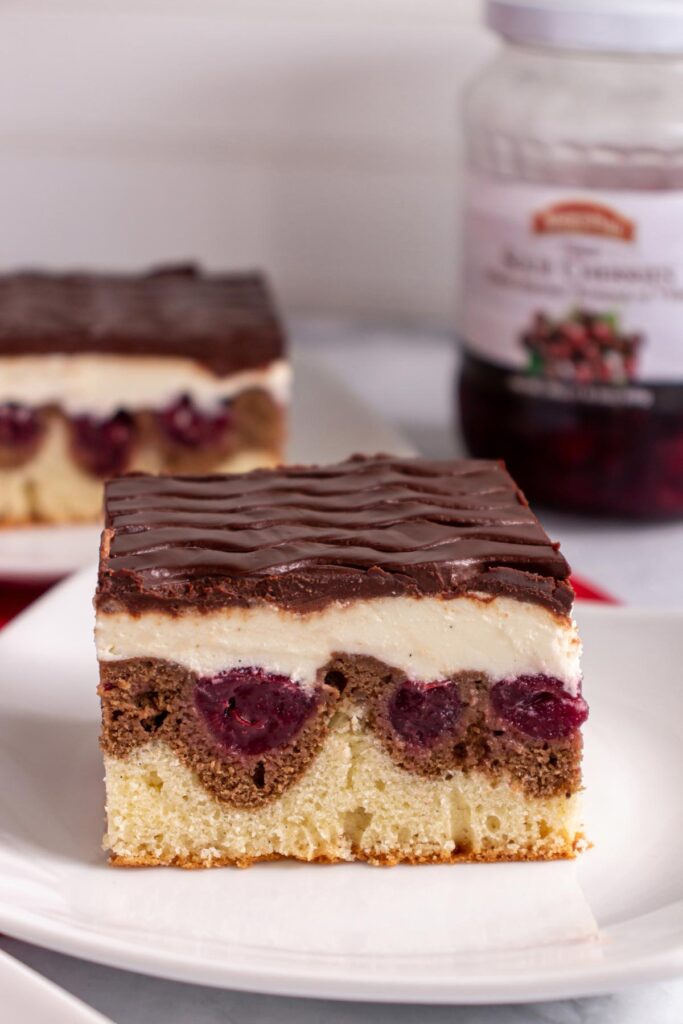
20) Donauwelle
Donauwelle, also known as the “Danube Wave Cake” or “Snow White Cake,” is a classic German dessert. It gets its name from its wavy pattern, reminiscent of the Danube River waves. This cake combines layers of vanilla and chocolate sponge cake, typically with sour cherries embedded in the batter.
To start, you need to preheat your oven to 350°F (180°C) and line a rectangular cake pan with parchment paper. This helps lift the cake out of the pan later. Prepare your dough by beating eggs with sugar until creamy, then add oil gradually.
Divide the dough in half. To one part, add cocoa powder and mix well. Pour the vanilla dough into the pan first, then layer the chocolate dough on top. The cherries are placed evenly across the top and slightly pressed down into the batter.
Bake the cake for about 35-40 minutes or until a toothpick comes out clean. Once baked, let it cool to room temperature.
The top is usually iced with a layer of German buttercream or vanilla pudding. The final layer is a chocolate glaze, made by melting chocolate and mixing in a bit of coconut oil. Spread this chocolate layer evenly over the buttercream.
Enjoy your Donauwelle with a cup of coffee or tea. The mix of flavors and textures makes this cake a delightful treat.
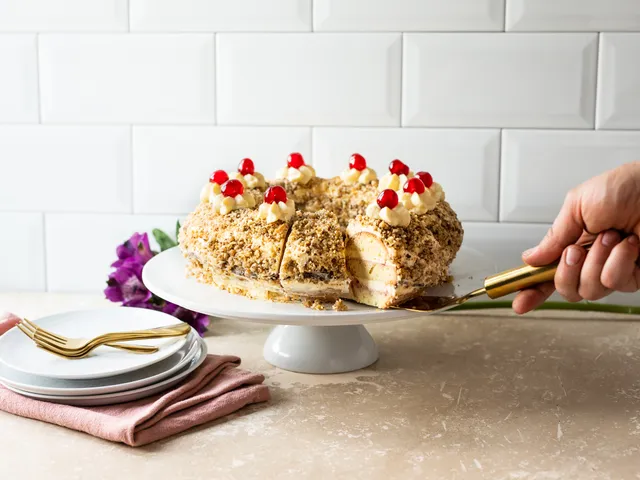
21) Frankfurter Kranz
Frankfurter Kranz, also known as Frankfurt Crown Cake, is a classic German dessert. It features layers of sponge cake, buttercream, and a crunchy praline coating.
You start by baking a light and fluffy sponge cake in a ring-shaped mold. This cake needs to cool completely before you begin assembling.
Next, you prepare the buttercream by beating softened butter with sugar and a hint of vanilla. This buttercream must be smooth and fluffy.
Once the cake is cool, slice it horizontally into layers. Spread a generous amount of buttercream between each layer. This step adds a rich and creamy texture.
After stacking the layers, cover the entire cake with more buttercream. The final touch is the praline coating, made from caramelized nuts. Sprinkle this all over the cake.
The result is a decadent and elegant dessert perfect for special occasions. The combination of flavors and textures makes Frankfurter Kranz a must-try for any dessert lover.
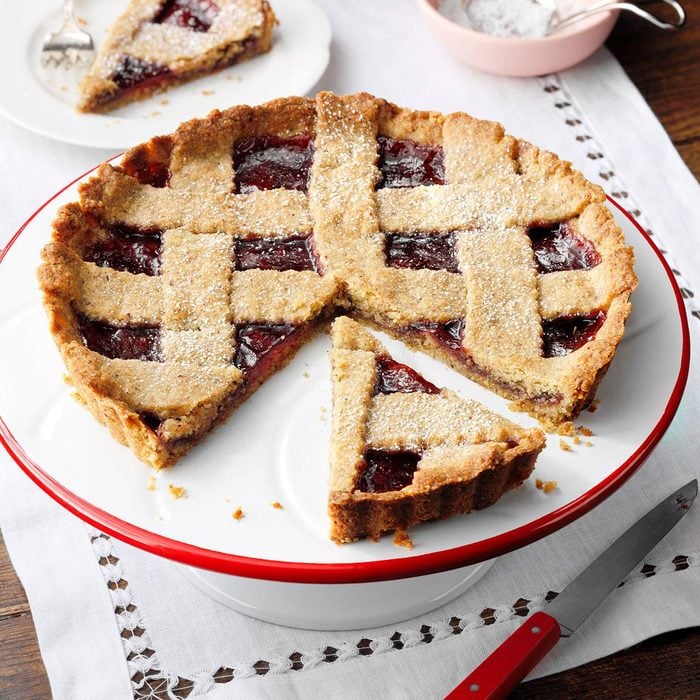
22) Linzer Torte
The Linzer Torte is a classic dessert with a rich history. It is often considered one of the oldest-known cakes in the world. The earliest recipe dates back to 1696, found in the city library of Vienna.
This torte is made with a buttery dough, typically containing ground nuts like almonds or hazelnuts. The dough is flavored with spices such as cinnamon and cloves.
After preparing the dough, you spread a layer of fruit preserves, usually raspberry or red currant jam, over a base crust. The top crust is formed by latticing strips of dough over the jam.
Ensure the torte bakes until it turns golden brown, which usually takes about 25 to 35 minutes. Once baked, let it cool completely before dusting with powdered sugar. This dessert is often enjoyed during holidays, but it is delicious any time of the year.
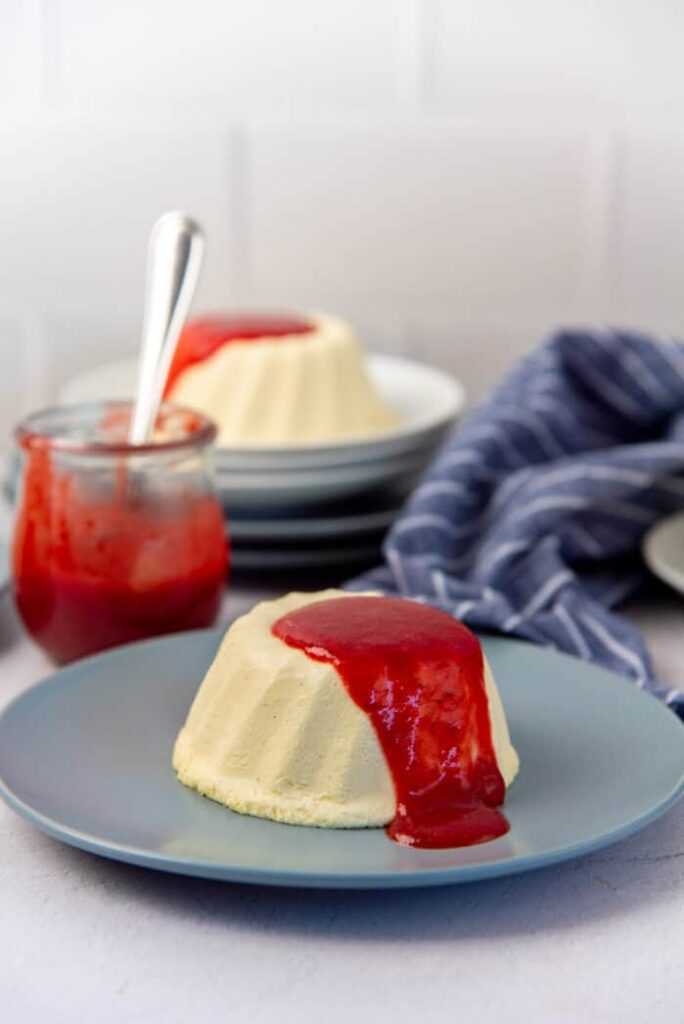
23) Bavarian Cream
Bavarian Cream is a delightful dessert that hails from Germany. It’s a smooth and creamy treat that’s enjoyed by many.
To make Bavarian Cream, you’ll need vanilla bean seeds, egg yolks, powdered sugar, gelatin, and heavy cream. Begin by splitting the vanilla bean and scraping out the seeds. Mix these with the egg yolks and sugar until they become thick and fluffy.
In a small bowl, sprinkle gelatin over cold milk. Let it sit for a few minutes before gently heating it. Combine this mixture with the egg yolks.
Next, whip heavy cream until it’s firm. Carefully fold the whipped cream into the egg mixture. This step ensures the cream stays light and airy.
Pour the mixture into small bowls or a large dish. Place it in the fridge for a few hours to set. Once it’s firm, Bavarian Cream is ready to be served.
Enjoy it plain or with a fruit topping. Its creamy texture and rich flavor make it a favored dessert for special occasions.
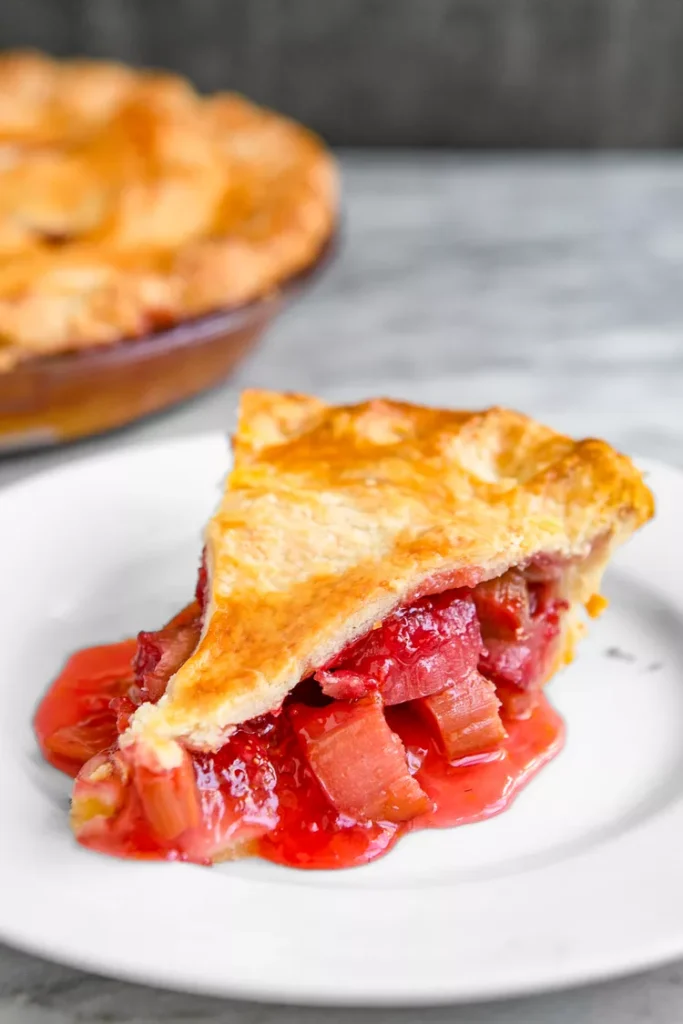
24) Strawberry Rhubarb Pie
Strawberry Rhubarb Pie combines sweet strawberries with tart rhubarb for a delicious treat. This dessert is a favorite because of its perfect balance of flavors. The filling is juicy, with a mix of strawberries, rhubarb, sugar, and a thickening agent like tapioca.
To make the pie, start by preheating your oven to 400°F (204°C). Prepare a double pie crust. Place the bottom layer into your pie plate, trimming any overhang. Combine the pie filling ingredients in a large bowl and mix well to coat the fruit evenly.
Pour the filling into the pie crust, then cover with the top crust. Cut small vents in the top crust to let steam escape. Bake for about 35-40 minutes, until the crust is golden brown and the filling is bubbly.
Enjoy your Strawberry Rhubarb Pie warm with a scoop of vanilla ice cream or let it cool before serving. This pie is perfect for summer gatherings or as a sweet ending to any meal.
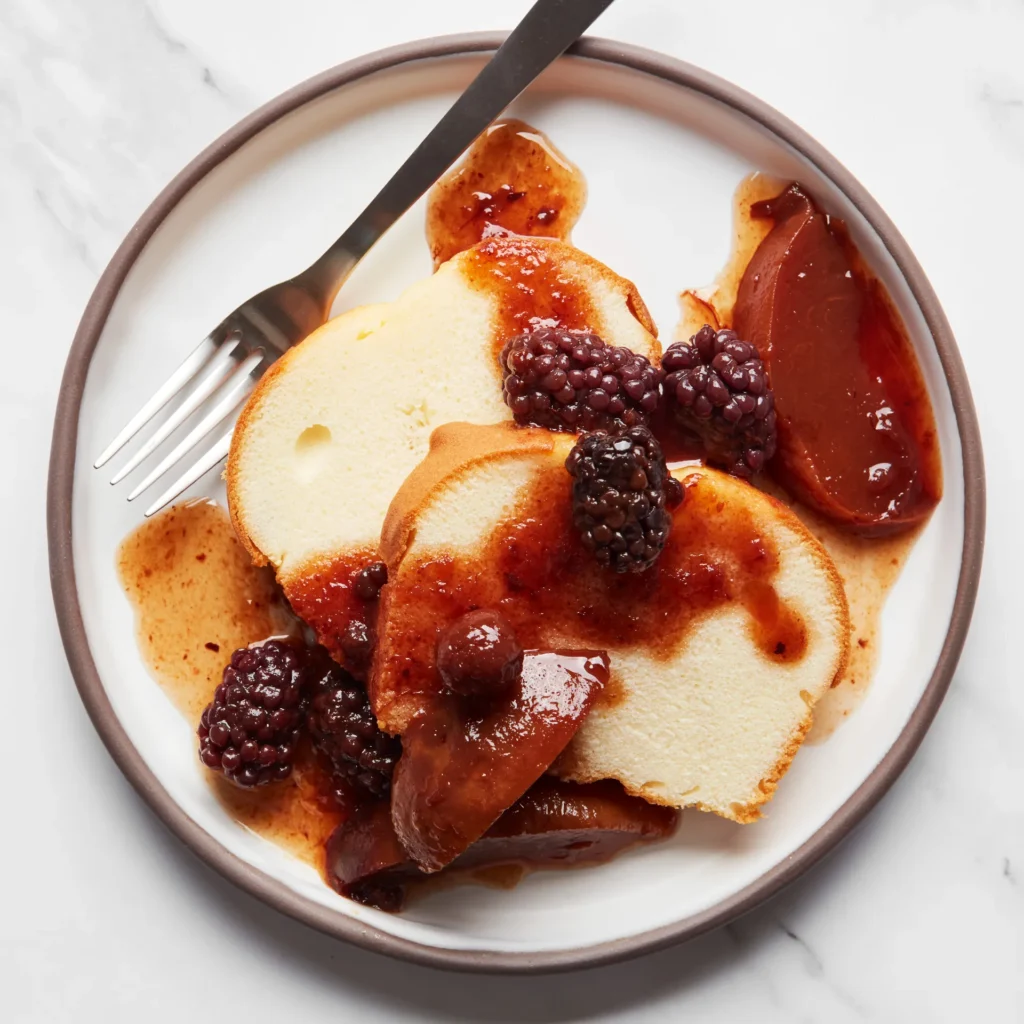
25) Rumtopf
Rumtopf is a traditional German dessert made by soaking fruits in rum and sugar. You start the process in summer when strawberries are ripe. Clean your fruits, cutting larger ones into halves or quarters. Layer the fruit in a large jar, adding a layer of sugar on top of each fruit layer.
Pour enough rum into the jar to cover the fruits. The rum preserves the fruit and creates a delicious mix. If the fruits float, use a weight to keep them submerged.
Continue adding fruit and sugar as new fruits come into season. Typical fruits include cherries, plums, peaches, pears, and grapes. By the end of autumn, your jar should be full of various fruits.
Rumtopf is often served during the winter holidays. You can enjoy it over ice cream, cake, or even on its own. The preserved fruits and the flavored rum make a sweet and aromatic treat that embodies the essence of summer fruits with a warming twist.
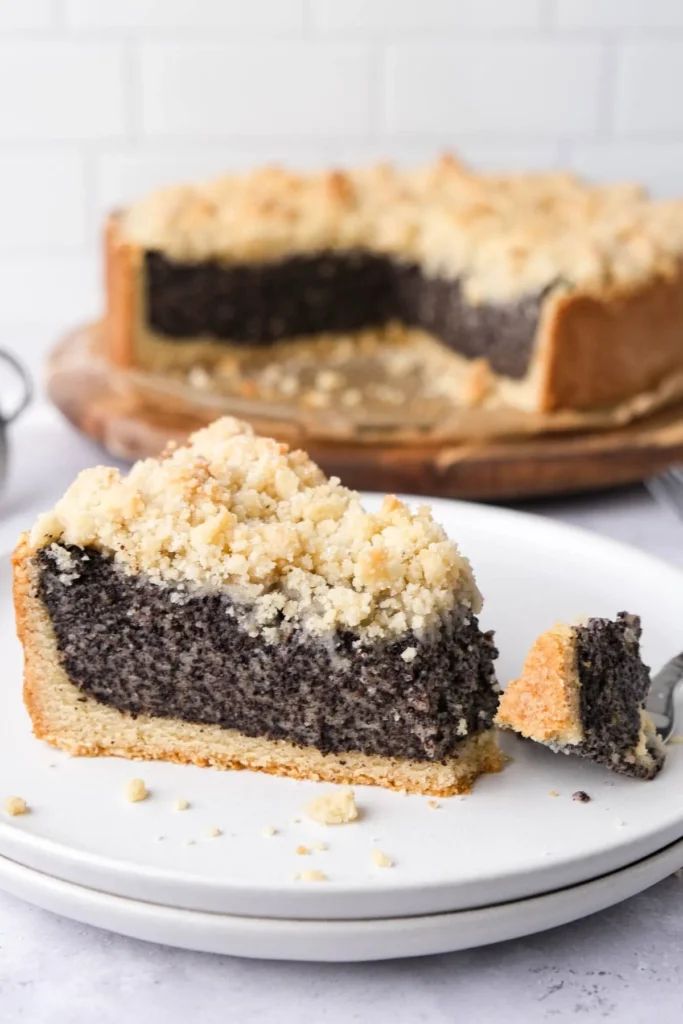
26) Mohnkuchen
Mohnkuchen, also known as German Poppy Seed Cake, is a delightful treat made with ground poppy seeds. This cake is popular in Germany and often has a moist, rich filling.
To prepare Mohnkuchen, you’ll need ingredients like milk, sugar, ground poppy seeds, and semolina. These basic ingredients create the creamy filling that is characteristic of this cake.
Start by heating the milk with sugar over medium heat until it begins to boil. Stir regularly to ensure the mixture doesn’t scorch. Once boiling, add the ground poppy seeds and cook for another couple of minutes.
Next, incorporate semolina into the mixture, continuing to stir while it thickens. This filling is then poured into a prepared crust, often made from a mixture of flour, sugar, and butter.
Many variations include adding drained cherries or a streusel topping. These additions give the Mohnkuchen an extra layer of flavor and texture.
Bake the cake at 350°F (175°C) for the recommended time, usually until the crust is golden and the filling sets. Let it cool before serving to allow the flavors to meld together perfectly.
Enjoy Mohnkuchen with a cup of coffee or tea for a delightful afternoon break.
Traditional Ingredients in German Desserts
German desserts are known for their unique flavors and rich textures. Key ingredients include various types of sugar, special flavorings, and specific grains and flours that give these sweets their distinctive taste.
Types of Sugar Used
German desserts often use different types of sugar to enhance flavor and texture. Granulated sugar is common in many recipes, providing a clean, sweet taste. Powdered sugar is frequently used for dusting cakes and pastries, adding a delicate finish.
Brown sugar appears in cookies and rich desserts like Lebkuchen, giving a deeper, molasses-like flavor. Some traditional recipes call for rock sugar or pearl sugar for a unique crunch, often seen in Stollen.
Unique Flavorings
Flavorings in German desserts are distinct and varied. One of the most beloved flavorings is cinnamon, which adds warmth to dishes like Apfelstrudel and Lebkuchen. Vanilla is another staple, often used in custards, creams, and cakes.
Almond extract gives a nutty aroma that is essential in marzipan. Liquors such as rum and Kirsch (cherry brandy) are used to add depth to flavors, particularly in festive cakes like Black Forest Cake and fruit preserves like Rumtopf.
Common Flours and Grains
The choice of flour and grains plays a crucial role in the texture of German desserts. All-purpose flour is widely used for cakes, cookies, and pastries. Rye flour is essential in some traditional cakes, providing a denser texture and earthier flavor.
Semolina is commonly used in puddings and dumplings. Another important ingredient is bread crumbs, which are used to add crunch and absorb moisture in dishes like Kirschmichel. Whole grains like oats may appear in cookies and bars, enhancing both flavor and nutrition.
Cultural Significance of German Desserts
German desserts hold a special place in the country’s culture and traditions. They are deeply tied to history and play an important role in various festivals and celebrations.
Historical Context
Many German desserts date back to centuries-old traditions. For instance, Apple Strudel and Black Forest Cake have roots in medieval European baking. These treats often originated from regions with plentiful local produce like cherries, apples, and grains. Traditional recipes have been handed down through generations, preserving unique flavors and methods.
Bread-based desserts like Kirschmichel were practical ways to use leftover bread, reflecting a frugal approach. Regional variations abound, with each area boasting its own specialties shaped by local agricultural products and cultural influences. This rich history gives them a beloved status in German cuisine.
Festivals and Celebrations
German desserts are integral to many holidays and seasonal events. During Christmas, markets are filled with Lebkuchen (gingerbread) and Stollen (fruit bread). Families gather to bake and share these festive treats, adding to the joy of the season.
Spaghetti Eis, a whimsical ice cream dish, is popular in summer festivals, especially among children. Oktoberfest features a variety of sweet treats alongside savory foods, emphasizing the celebratory nature of desserts.
They are not just food but symbolize the coming together of family and friends, marking important cultural moments and shared memories.
Mastering the Techniques
Perfecting German desserts requires knowing specific baking essentials and honing decorating skills.
Baking Essentials
Understanding ingredients is crucial in German baking. Quality matters, so always use fresh butter, eggs, and flour. Spices like cinnamon and cardamom often appear in traditional recipes.
Temperature control is vital. Make sure to preheat your oven and maintain consistent temperatures. Some German desserts, such as Stollen, require low and slow baking to develop flavors properly.
Dough preparation is another key aspect. Whether it’s the delicate layers of an apple strudel or the rich dough of a butter pound cake, handling dough with care ensures perfect texture. Roll it thin for strudel, but keep it thick and uniform for cakes.
Decorating Skills
Presentation enhances the appeal of any dessert. For apple strudel, a sprinkle of powdered sugar adds a classic touch.
Icing and glazing are prominent in many German desserts. Marzipan is often used in Stollen, while simple sugar glazes can elevate cakes.
Garnishing with fruits or nuts not only adds flavor but also visual interest. Adding a dollop of whipped cream or a drizzle of vanilla sauce can make your dessert look and taste even better.
Practicing these techniques will help you achieve the authentic taste and appearance of traditional German desserts.
